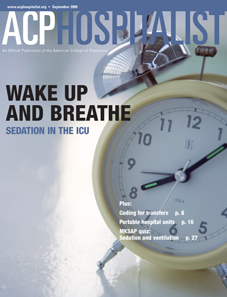Excessive consults stem from lack of time for primary care
The pressure to see patients every 15 minutes does not leave much time to work complex diagnoses or manage chronic diseases. And haphazard referrals drive up the cost of care for everyone. Health care reform needs to incentivize quality of care rather than amounts of care.
While I was in training, I believed that comprehensive care obligated general internists to personally provide for all of their patients' medical needs. As unrealistic and dangerous for patients as that extreme notion was—in fact, one section of a modern Hippocratic Oath reads, in part, “I will not be ashamed to say ‘I know not,’ nor will I fail to call in my colleagues when the skills of another are needed for a patient's recovery”—the reality of our referral patterns in today's health care system has gone to the opposite extreme and can be equally dangerous.
A comparative study revealed that American primary care physicians refer about one in three patients, whereas their British counterparts refer one in seven, regardless of the case-mix.
Many might presume that the higher referral rate would translate into higher-quality health care. Sadly, comparative quality benchmarks do not bear this out. In fact, the higher referral rate is likely a direct consequence of our volume-based reimbursement system, which is potentially detrimental to the quality of care and is certainly detrimental to the joy of practicing primary care.
The pressure to see patients every 15 minutes does not leave much time to work up an undifferentiated problem like shortness of breath or to manage all the nuances of a chronic disease like inflammatory bowel disease. The primary care physician feels more like a traffic cop directing patients to the next consultant rather than a physician skilled in comprehensive, coordinated and longitudinal care.
While patients and their families might feel better at the prospect of seeing an expert, too often these referrals are done haphazardly. Patients show up at the consultants' offices with no prior records and no clear communication of the reasons for the consults.
Further, patients often have multiple problems or chronic diseases, and so are often referred to multiple consultants, a condition I refer to as “consultation malignans.” This malady is as dangerous and epidemic as obesity. Multiple referrals without meticulous attention to care coordination can lead to conflicting regimens, medical errors, mixed messages and, at best, global confusion.
On the other side of the referral process, the perverse incentives of our system promote care that is expensive, and perhaps even unnecessary and detrimental. Why talk with a patient for 30 minutes when a colonoscopy or catheterization in the same time generates four times the profit? Better to hire a midlevel to do all the talking, and let your magic fingers do the rest. Nothing makes my day more complete as a general internist than referring a complex patient to a specialist and getting back a note from the specialist's midlevel, who saw the patient while the specialist was operating.
Worse is the so-called “chain reaction consultation” where a patient is referred for a particular problem, but during the work-up, another one surfaces such as an unexpected finding on a CT scan or lab test. The consultant refers the patient to yet another consultant, a “second generation” consultation, often without informing the primary care physician. The “second generation” consultation can in turn lead to “third and fourth generation” consultations before the patient ever gets back to the primary care physician.
Too often, patients return to the primary care physician looking as though they have been through a nuclear blast of medical procedures and diagnostics without ever having had the original problem addressed. One can only hope that by this time they have simply forgotten about the original problems and are grateful to just be alive.
The key to a constructive consult is the information exchanged between the primary physician and the consultant. One of the most fundamental issues is understanding the different types of consults. In a recent article, Forrest divided consultations into four types: cognitive, procedural, comanagement with shared care of the health problem, or comanagement with the consultant providing principal care for the health problem.
Within each of these types of consults, primary care physicians and specialists need to clearly define their obligations and roles. We need to establish guidelines and quality metrics for the consultation handoff that might actually be as important for overall care as the guidelines and metrics for the disease itself. Improving the quality of the handoff can help avoid unneeded tests and procedures, and enable more individually tailored work-up and treatment plans.
Ultimately, improving collaboration between primary care physicians and consultants will require a change in the incentive structure of the delivery system. We need to incentivize quality of care rather than amounts of care. Newer models of care such as the patient-centered medical home and accountable care organizations will create a more caring and fulfilling relationship between doctors and their colleagues.




